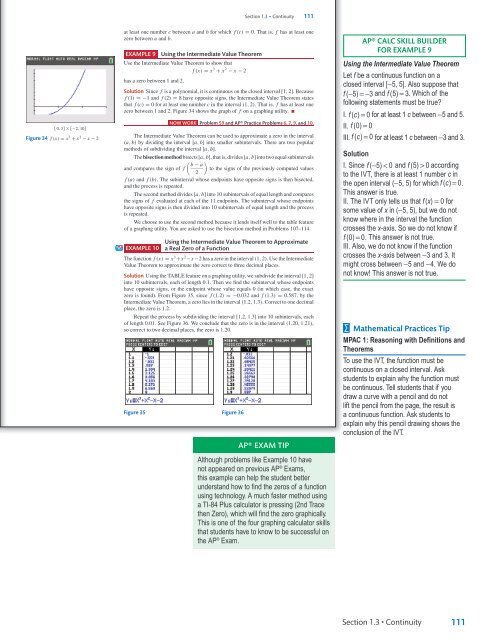Sullivan Microsite DigiSample
Create successful ePaper yourself
Turn your PDF publications into a flip-book with our unique Google optimized e-Paper software.
<strong>Sullivan</strong> AP˙<strong>Sullivan</strong>˙Chapter01 October 8, 2016 17:4<br />
Section 1.3 • Continuity 111<br />
f 0, 3g 3 f22, 10g<br />
Figure 34 f (x) = x 3 + x 2 − x − 2<br />
at least one number c between a and b for which f (c) = 0. That is, f has at least one<br />
zero between a and b.<br />
EXAMPLE 9<br />
Using the Intermediate Value Theorem<br />
Use the Intermediate Value Theorem to show that<br />
f (x) = x 3 + x 2 − x − 2<br />
has a zero between 1 and 2.<br />
Solution Since f is a polynomial, it is continuous on the closed interval [1, 2]. Because<br />
f (1) =−1 and f (2) = 8 have opposite signs, the Intermediate Value Theorem states<br />
that f (c) = 0 for at least one number c in the interval (1, 2). That is, f has at least one<br />
zero between 1 and 2. Figure 34 shows the graph of f on a graphing utility. ■<br />
NOW WORK Problem 59 and AP® Practice Problems 6, 7, 9, and 10.<br />
The Intermediate Value Theorem can be used to approximate a zero in the interval<br />
(a, b) by dividing the interval [a, b] into smaller subintervals. There are two popular<br />
methods of subdividing the interval [a, b].<br />
The bisection method bisects [a, b], that is, divides [a, b] into two equal subintervals<br />
( ) b − a<br />
and compares the sign of f to the signs of the previously computed values<br />
2<br />
f (a) and f (b). The subinterval whose endpoints have opposite signs is then bisected,<br />
and the process is repeated.<br />
The second method divides [a, b] into 10 subintervals of equal length and compares<br />
the signs of f evaluated at each of the 11 endpoints. The subinterval whose endpoints<br />
have opposite signs is then divided into 10 subintervals of equal length and the process<br />
is repeated.<br />
We choose to use the second method because it lends itself well to the table feature<br />
of a graphing utility. You are asked to use the bisection method in Problems 107–114.<br />
EXAMPLE 10<br />
Using the Intermediate Value Theorem to Approximate<br />
a Real Zero of a Function<br />
The function f (x) = x 3 +x 2 −x −2 has a zero in the interval (1, 2). Use the Intermediate<br />
Value Theorem to approximate the zero correct to three decimal places.<br />
Solution Using the TABLE feature on a graphing utility, we subdivide the interval [1, 2]<br />
into 10 subintervals, each of length 0.1. Then we find the subinterval whose endpoints<br />
have opposite signs, or the endpoint whose value equals 0 (in which case, the exact<br />
zero is found). From Figure 35, since f (1.2) =−0.032 and f (1.3) = 0.587, by the<br />
Intermediate Value Theorem, a zero lies in the interval (1.2, 1.3). Correct to one decimal<br />
place, the zero is 1.2.<br />
Repeat the process by subdividing the interval [1.2, 1.3] into 10 subintervals, each<br />
of length 0.01. See Figure 36. We conclude that the zero is in the interval (1.20, 1.21),<br />
so correct to two decimal places, the zero is 1.20.<br />
Figure 35 Figure 36<br />
AP® Exam Tip<br />
Although problems like Example 10 have<br />
not appeared on previous AP ® Exams,<br />
this example can help the student better<br />
understand how to find the zeros of a function<br />
using technology. A much faster method using<br />
a TI-84 Plus calculator is pressing (2nd Trace<br />
then Zero), which will find the zero graphically.<br />
This is one of the four graphing calculator skills<br />
that students have to know to be successful on<br />
the AP ® Exam.<br />
AP® Calc Skill Builder<br />
for Example 9<br />
Using the Intermediate Value Theorem<br />
Let f be a continuous function on a<br />
closed interval [−5, 5]. Also suppose that<br />
f ( − 5) =− 3and f (5) = 3. Which of the<br />
following statements must be true?<br />
I. f() c= 0 for at least 1 c between −5 and 5.<br />
II. f (0) = 0<br />
III. f() c= 0 for at least 1 c between −3 and 3.<br />
Solution<br />
I. Since f ( − 5) < 0 and f (5) > 0according<br />
to the IVT, there is at least 1 number c in<br />
the open interval (−5, 5) for which fc () = 0.<br />
This answer is true.<br />
II. The IVT only tells us that f (x) = 0 for<br />
some value of x in (−5, 5), but we do not<br />
know where in the interval the function<br />
crosses the x-axis. So we do not know if<br />
f (0) = 0. This answer is not true.<br />
III. Also, we do not know if the function<br />
crosses the x-axis between −3 and 3. It<br />
might cross between −5 and −4. We do<br />
not know! This answer is not true.<br />
∑ Mathematical Practices Tip<br />
MPAC 1: Reasoning with Definitions and<br />
Theorems<br />
To use the IVT, the function must be<br />
continuous on a closed interval. Ask<br />
students to explain why the function must<br />
be continuous. Tell students that if you<br />
draw a curve with a pencil and do not<br />
lift the pencil from the page, the result is<br />
a continuous function. Ask students to<br />
explain why this pencil drawing shows the<br />
conclusion of the IVT.<br />
Section 1.3 • Continuity<br />
111<br />
TE_<strong>Sullivan</strong>_Chapter01_PART I.indd 8<br />
11/01/17 9:58 am




